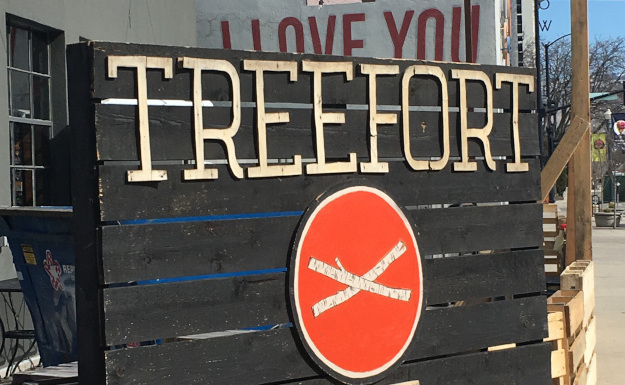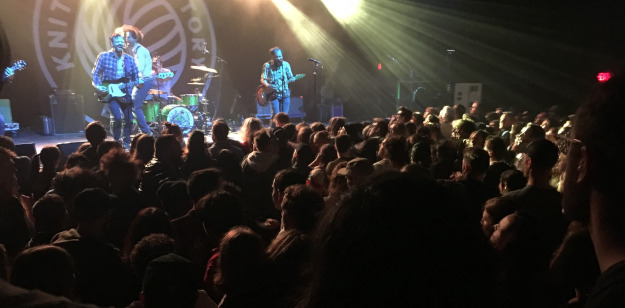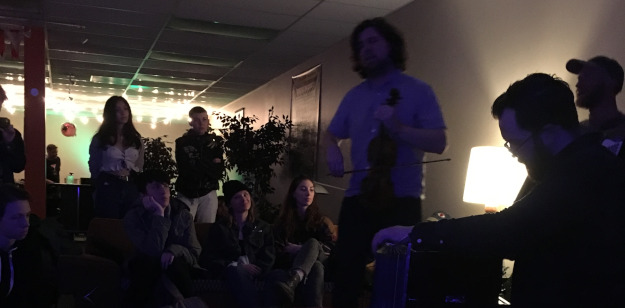Bodies in Space at Treefort 2019

Written by Scott Draper
Year eight of Boise's Treefort festival was replete as always with random acts of senseless lovingkindness, munificent beards, and bands that somehow involve Doug Martsch. Easy to manage and open in spirit, the festival is extremely well suited for performances that play around and experiment with different ways of engaging crowds and spaces.
Scheduled each year about a week after Austin's SXSW (which is so famous that I don't even need to spell it), Treefort feels like a much smaller and way more chill after-party. Performers repeatedly expressed from stage this year how well the Treefort staff takes care of them, how it's all so well planned, etc., in some cases even comparing Treefort favorably to SX.
Treefort is designed to look more or less like an expansive tree fort (obviously) taking over a small downtown. The shows this year took place in twenty or so different venues, each with its own distinct feel. Several of this year's performers excelled at moving around and within these spaces, manipulating stage conventions in ways that spawned effervescent rock and roll rituals.
For example:
- Boise's The Moody Jews just absolutely bringing the klezmer while working the Pengilly's Saloon dance floor (Wed.)
- Kim West and Ryan Devlin of Seattle's Smokey Brights at the Olympic, cavorting emotionally on top of the tall downstage speakers, and then later Devlin burrowing through the crowd to play a bitchin' guitar solo atop the bar (Thurs.)
- Aaron Weiss of Philadelphia's mewithoutYou, at the Knitting Factory, starting the show with some crowd surfing, skipping altogether any old-fashioned “let's-get-to-know-each-other-first" formalities with the crowd. (Sat.)
- Annakalmia Traver of Brooklyn's Rubblebucket on the Mainstage, persuading the large crowd to get on the ground, point anywhere, and intone the word “love." (Sun.)
In each case, the performers' choice to somehow violate the fourth wall and physically engage audience members visibly and audibly intensified the crowd's level of rhythmic and emotional connection with the music, thus also with each other.

Two moments in particular felt transcendent, at least for me. Both moments happened on Friday afternoon, both involved relatively new bands, and both came unexpectedly.
The first occurred at the Boise All-Ages Movement Project (“B-AMP"), in a show by Reno's People With Bodies. The crowd was small but the band didn't seem to mind, and even used the crowd's size to the show's advantage. Along with their songs, they read us all a George Saunders story about malevolent potato chips. At another point, for their song “Bardo," they invited us to join them in shutting up completely at certain points in the music, collectively concentrating on some very long silences. These meditative moments were interrupted a couple times by sounds of chatter from a staff member's walkie-talkie, which actually sounded pretty cool, almost like a fourth instrument in the context of the song.
The peak moment of the People with Bodies show, though, was the set's final song “Seer." B-AMP is basically a large room with the entrance on one side and a stage on the other. In a corner near the entrance, a few couches and chairs surround a decorative electric fireplace. For “Seer," drummer/vocalist Fil Corbitt pointed to the fireplace and asked everyone to gather. The band left the stage, whipped out a violin, accordion, and harmonium, walked over to the fireplace, taught us the refrain, and then promptly transformed a punk show into a warm and intimate sing-along pub session.
After the show, as a few of us stood around for a minute just kind of savoring the buzz, some dude who had been sitting on one of the couches in the back throughout most of the show turned to me and said, “Well shit. I was just sitting back there sobering up, but they came to me!"

This may be a key insight for performers: beyond just playing really well together and hoping the audience feels it too, they can create ways to take the show to the audience. Mark Nesbitt, People with Bodies' bassist, explained his band's approach to me later as follows:
Live music at its best connects people over a common experience…. We approach every show with the audience in mind, with the room in mind, and with some sort of performative element in mind. Sometimes that's intimacy, sometimes it's wonder or breaking expectations, and sometimes it's even pushing an audience out of its comfort zone to engage with the band in a way that's more interactive and less transactional.
“Connecting people over a common experience" is a good way to also sum up my other most transcendent Treefort moment, which in this case took place not in a bar or music hall, but on a City of Boise bus. San Francisco's Good Not Great apparently gained access to a city bus, and rode around town much of Friday afternoon playing high-spirited bluegrass as the driver drove the usual route. The band rode around and belted songs, beckoning pausing pedestrians to “Get on! It's free! How often do you get to see bluegrass on a bus?!?"
Inside the bus was a wobbling tangle of people. Because they were all riding a bus, no one in the audience could avoid moving and shaking. In general, the traveling concert in all its forms (subways, railroad cars, etc.) strikes me as a pretty brilliant solution to the problem of how to get an audience moving. Good Not Great's choice of venue on Friday afternoon meant that everyone in their mobile ritual was in a tight space, probably dancing or at least swaying in a common rhythm (again, this was all on a bus!).
My commute was ecstatic and bumpy to a degree that I have to confess I did not take very good journalistic notes. My memory of the ride, though, involves: floral print shirts; numerous instruments including a fiddle, banjo, and guitar; feats of superb balance; spinning propeller beanies; several pairs of very short shorts; commuters dancing in the aisle; commuters dancing on their seats; someone who might possibly have been wearing an elf costume; good music (I'd say great, but you know…); and most everyone grabbing onto handrails and seat corners, singing loud and cracking up. Now that is a good use of venue.

Scott Draper studies effervescent rituals for a living. His book Religious Interaction Ritual: The Microsociology of the Sprit was recently published by Lexington Press.



